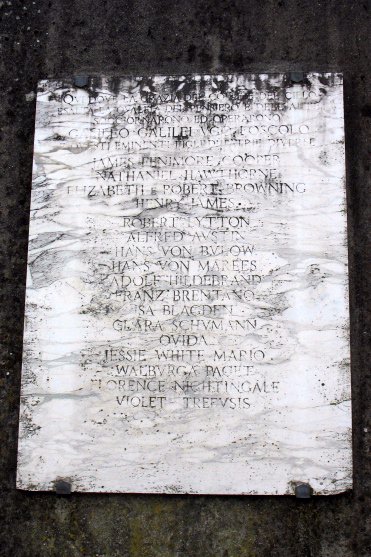

![]() Nahe dem Eingang zur Villa Ombrellino
auf einer Anhöhe südlich von Florenz befindet sich eine Marmortafel, deren Text
in italienischer Sprache eine ganze Reihe bekannter Persönlichkeiten benennt. Aus
Sicht der Mathematikgeschichte sind davon
Galileo
Galilei und
Florence
Nightingale (siehe auch die Beschreibung zur
10£-Banknote mit ihrem Konterfei) interessant.
Nahe dem Eingang zur Villa Ombrellino
auf einer Anhöhe südlich von Florenz befindet sich eine Marmortafel, deren Text
in italienischer Sprache eine ganze Reihe bekannter Persönlichkeiten benennt. Aus
Sicht der Mathematikgeschichte sind davon
Galileo
Galilei und
Florence
Nightingale (siehe auch die Beschreibung zur
10£-Banknote mit ihrem Konterfei) interessant.
G. Galilei lebte von 1617 bis 1631 in der Villa Ombrellino. In dieser Zeit entstand sein berühmter Dialog.
Der Text auf dem Bild links ist nicht sicher vollständig zu erkennen, er kann jedoch [2] - diese Ausarbeitung basiert auf [1] - entnommen und wie folgt übersetzt werden:
| Hier, wo die Schönheit der Hügel und des Himmels das Denken und die Kunst anregt, lebten und wirkten Galileo Galilei, Ugo Foscolo [Dichter] und diese bedeutenden Söhne und Töchter verschiedener Nationen James Fenimore Cooper [amerikanischer Schriftsteller, Autor des Lederstrumpf] Nathaniel Hawthorne [amerikanischer Schriftsteller] Elizabeth & Robert Browning [englische Dichterin / englischer Dichter und Dramatiker] Henry James [amerikanischer Schriftsteller] Robert Lytton [englischer Staatsmann und Dichter, Viceroy von Indien] Alfred Austin [englischer Dichter und Schriftsteller] Hans von Bülow [1. Dirigent der Berliner Philharmoniker] Hans von Marees [deutscher Maler] Adolf Hildebrand [deutscher Bildhauer] Franz Brentano [deutscher Philosoph und Psychologe] Isa Blagden [Dichterin, gesellschaftlicher Mittelpunkt] Clara Schumann [deutsche Pianistin und Komponistin] Ouida [Pseudonym der englischen Schriftstellerin Marie Louise de la Ramée] Jessie White Mario [englische Schriftstellerin und Philanthropin] Walburga Paget [deutsche Schriftstellerin] Florence Nightingale [Pionierin der modernen Krankenpflege] Violet Trefusis [englische Schriftstellerin] |
Das Foto wurde im Juli 2009 von Andreas Stelter aufgenommen.
![]() Near to the entrance of the Villa
Ombrellino on a hill south to the city of Florence a marble plaque can be found whose
Italian text presents the names of several famed personages. From the view of history of
mathematics the names of
Galileo
Galilei and
Florence
Nightingale (see also the description of
10£ banknote showing her) are especially interesting.
Near to the entrance of the Villa
Ombrellino on a hill south to the city of Florence a marble plaque can be found whose
Italian text presents the names of several famed personages. From the view of history of
mathematics the names of
Galileo
Galilei and
Florence
Nightingale (see also the description of
10£ banknote showing her) are especially interesting.
G. Galilei lived in the Villa Ombrellino from 1617 up to 1631. During this period he wrote his wellknown Dialogue.
The inscription is hard to recognize on the photograph. But it can be taken from [2] (which refers on [1]) and can be provided as follows:
The photograph was taken in July 2009 by Andreas Stelter.
| [1] | Giannarelli, Elena und Pellis, Lorella: Donne Di Pietra: Storie Al Femminile Scolpite Sui Muri Di Firenze, Giorgi & Gambi, Florenz 1999, ISBN 88-87339-01-5 | |
| [2] | Turner, Nicoletta: Florence's women of stone, http://villasantalucia.net/pdfs/stone women of Florence.pdf |
| Back to the main page | Created by Wolfgang Volk in March 2010 Last correction on March 2nd, 2012 |